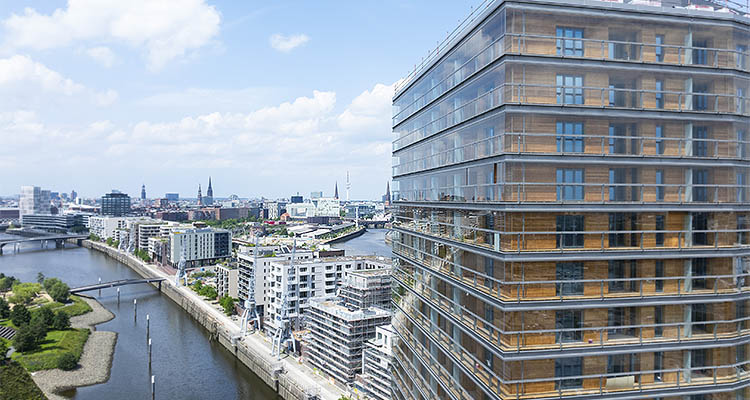The future of sustainable building. By Helmut Schuller, CEO, SCHULLER&Company
We see hybrid construction not just as a method, but as a platform for the future of sustainable building.” — Helmut Schuller, CEO, SCHULLER&Company
A sector in transition
The construction industry is experiencing a profound change. Climate change and the associated CO₂ reduction targets are forcing companies to rethink their use of materials. At the same time, a shortage of skilled labour and increasing time pressure make automation and digitalisation unavoidable. Projects are becoming more complex, while quality expectations continue to rise, demanding closer coordination across disciplines. New regulations and incentive schemes are creating additional momentum by rewarding sustainable methods and BIM-based workflows. Finally, the arrival of new materials such as green steel and recycled concrete is reshaping the technical and economic foundations of the sector. 
The combination of these forces makes it clear that traditional approaches are no longer sufficient. What is needed is a building method that combines sustainability with efficiency, and that can integrate diverse expertise into a coherent process. Hybrid construction has emerged as precisely this solution.
The concept of hybrid construction
Hybrid construction is the intelligent combination of materials such as steel, timber and concrete in a single project. Each material contributes its specific strengths: steel ensures structural stability and long spans, timber is CO₂ storage of 680 kg/m³, while concrete delivers robustness, durability and fire resistance. By orchestrating these properties in a complementary way, hybrid methods can achieve performance and sustainability levels that would be difficult to reach with any one material alone.
Importantly, true sustainability cannot be achieved by relying solely on a single “green” material. Timber is renewable, but its processing often involves adhesives, resins and significant energy input. Concrete remains problematic due to the emissions from cement production, while conventional steel production is carbon intensive. Yet, innovations such as hydrogen-based or recycled steel are beginning to shift the balance. Hybrid construction leverages these advances, applying each material where it offers the best ecological and technical outcome.
Prefabrication and modularity
Hybrid methods are closely linked with prefabrication and modular construction. Large components can be premanufactured in controlled environments and then delivered just in time to the building site. This reduces not only the overall construction time, but also noise, emissions and errors. The higher precision of factory production means fewer adjustments on site and a lower risk of costly rework. Studies show that modular construction can cut project time by 20-to-50 per cent and reduce costs by up to 20 per cent, while also lowering on-site risks and, in some cases, halving embodied CO₂ emissions.
Projects such as Roots Hamburg, one of Europe’s tallest timber-hybrid residential towers, or the World of Volvo experience centre in Gothenburg illustrate the potential of this approach. Both projects combine timber with steel and concrete elements, and both rely heavily on prefabricated modules. Even under extreme conditions, such as the Polish Polar Station in Antarctica, hybrid construction with prefabricated elements ensures a reliable and rapid building process. These examples demonstrate that hybrid methods are not limited to one project type but can be applied to urban housing, cultural landmarks and industrial facilities alike.
Digitalisation as a prerequisite
The growing complexity of hybrid construction would be unmanageable without digital tools. Building Information Modelling (BIM) and artificial intelligence are now indispensable for planning, coordinating and documenting projects. Digitalisation and sustainability are no longer contradictory goals; they enable one another.
Yet the BIM software landscape remains fragmented, with many projects relying on highly specialised solutions that do not integrate well. This creates data incompatibilities and increases the coordination effort. At SCHULLER&Company, we developed bocad Hybrid to address this problem. The software platform is an open interface combining mixed tools to provide a unified environment that covers all relevant materials, from design through to production. By doing so, it allows planners and fabricators to manage hybrid workflows without the friction of transferring data between separate tools.
 bocad Hybrid in practice
bocad Hybrid in practice
The value of an integrated BIM solution becomes clear when looking at the requirements of hybrid projects. Designing must be precise to ensure that steel frames align perfectly with timber modules or concrete cores. Coordination must be seamless to prevent errors at the interfaces between trades. And fabrication requires exact data for NC and CAM systems to minimise waste and manual intervention.
bocad Hybrid delivers on these requirements by modelling multi-material structures in one environment, detecting potential clashes at an early stage, and generating detailed fabrication data directly from the model. It covers all materials and machine manufacturers. Automated routines for materials-specific details, such as notches in timber panels or cut-outs in glass façades, save time while improving accuracy. With the new bocad Hybrid solution, all material modules are bundled, creating maximum flexibility for engineers who want to extend established steel workflows into full hybrid solutions.
Digital twins across the life cycle
Digitalisation in hybrid construction does not end with design and fabrication. The concept of the digital twin is increasingly important across the lifecycle of a building in order to increase sustainability. All relevant information is bundled in one model, accessible to all stakeholders at every stage. During design, this ensures greater accuracy and coordination. During operation, it supports efficient maintenance and facility management. And at the end of life, it enables components to be identified, verified and reused in new projects. This circular perspective reduces costs and conserves resources, turning the digital twin into a cornerstone of sustainable construction. Hybrid construction, supported by advanced BIM tools and digital twins, enables companies to stay competitive, delivering projects faster and more economically while also meeting climate targets.

 bocad Hybrid in practice
bocad Hybrid in practice